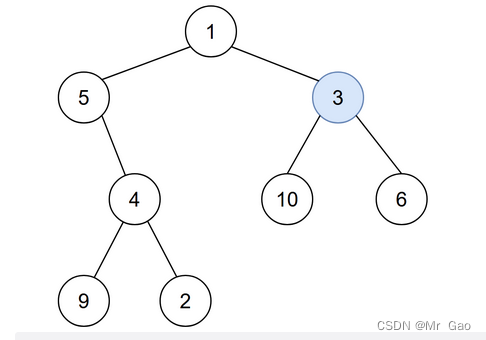热门标签
热门文章
- 1docker compose 报超时error pulling image configuration: tcp 104.18.123.25:443: i/o timeout_error pulling image configuration: download failed
- 2在Ubuntu中编译Android的内核和文件系统_ubuntu 编译安卓内核
- 3讯飞免费星火大模型部署教程_讯飞星火大模型怎么插入其他模型
- 4uniapp 实现不同用户展示不同的tabbar(底部导航栏)_自定义tabbar 配置
- 5【非原创】python调用bartender操控打印机打印条码_python bartender
- 6队列的实现_队列实现
- 7word文档找不到smartart_如何学习计算机二级?——Word篇
- 8人工智能与大数据专业毕设选题汇总 最新版
- 9流畅的python阅读笔记
- 10无人机技术,无人机远程无线图传技术详解,无人机图像传输技术解析_无人机摄像wifi传播距离是多少
当前位置: article > 正文
2385. 感染二叉树需要的总时间将-树转化为图+邻接表+广度优先遍历
作者:小小林熬夜学编程 | 2024-04-29 22:25:19
赞
踩
2385. 感染二叉树需要的总时间将-树转化为图+邻接表+广度优先遍历
2385. 2385. 感染二叉树需要的总时间将-树转化为图+邻接表+广度优先遍历
给你一棵二叉树的根节点 root ,二叉树中节点的值 互不相同 。另给你一个整数 start 。在第 0 分钟,感染 将会从值为 start 的节点开始爆发。
每分钟,如果节点满足以下全部条件,就会被感染:
节点此前还没有感染。
节点与一个已感染节点相邻。
- 1
- 2
返回感染整棵树需要的分钟数。
示例 1:

输入:root = [1,5,3,null,4,10,6,9,2], start = 3
输出:4
解释:节点按以下过程被感染:
- 第 0 分钟:节点 3
- 第 1 分钟:节点 1、10、6
- 第 2 分钟:节点5
- 第 3 分钟:节点 4
- 第 4 分钟:节点 9 和 2
感染整棵树需要 4 分钟,所以返回 4 。
示例 2:

输入:root = [1], start = 1
输出:0
解释:第 0 分钟,树中唯一一个节点处于感染状态,返回 0 。
我这题的做法时很有趣的,因为使用了图的很多内容,感兴趣的可以学习一下:
/** * Definition for a binary tree node. * struct TreeNode { * int val; * struct TreeNode *left; * struct TreeNode *right; * }; */ int count; void node_num(struct TreeNode* root){ if(root){ node_num(root->left); node_num(root->right); count++; } } struct graph{ int val; struct graph *next; }; void add_graph(struct graph *G,int vex,int next){ struct graph *node=(struct graph *)malloc(sizeof(struct graph)); node->val=next; node->next=(G+vex)->next; (G+vex)->next=node; } void transform_tree_to_graph(struct graph *G,struct TreeNode* root){ if(root){ int vex=root->val; if(root->left){ int next=root->left->val; add_graph(G,vex,next); add_graph(G,next,vex); transform_tree_to_graph(G,root->left); } if(root->right){ int next=root->right->val; add_graph(G,vex,next); add_graph(G,next,vex); transform_tree_to_graph(G,root->right); } } } void print(struct graph *G){ for(int i=0;i<count;i++){ struct graph *p=(G+i)->next; while(p){ printf("%d ",p->val); p=p->next; } } } int amountOfTime(struct TreeNode* root, int start){ count=0; node_num(root); int size=200000; struct graph *G=(struct graph *)malloc(sizeof(struct graph)*(size)); int visit[size]; for(int i=0;i<size;i++){ (G+i)->next=NULL; visit[i]=1; } transform_tree_to_graph(G,root); // print(G); int Q[size]; int rear=0,front=0; Q[rear++]=start; Q[rear++]=-1; int time=0; while(front!=rear){ int de=Q[front++]; if(de==-1){ time++; if(rear!=front){ Q[rear++]=-1; } continue; } visit[de]=0; struct graph *p=(G+de)->next; while(p){ if(visit[p->val]){ Q[rear++]=p->val; visit[p->val]=0; } p=p->next; } } return time-1; }
- 1
- 2
- 3
- 4
- 5
- 6
- 7
- 8
- 9
- 10
- 11
- 12
- 13
- 14
- 15
- 16
- 17
- 18
- 19
- 20
- 21
- 22
- 23
- 24
- 25
- 26
- 27
- 28
- 29
- 30
- 31
- 32
- 33
- 34
- 35
- 36
- 37
- 38
- 39
- 40
- 41
- 42
- 43
- 44
- 45
- 46
- 47
- 48
- 49
- 50
- 51
- 52
- 53
- 54
- 55
- 56
- 57
- 58
- 59
- 60
- 61
- 62
- 63
- 64
- 65
- 66
- 67
- 68
- 69
- 70
- 71
- 72
- 73
- 74
- 75
- 76
- 77
- 78
- 79
- 80
- 81
- 82
- 83
- 84
- 85
- 86
- 87
- 88
- 89
- 90
- 91
- 92
- 93
- 94
- 95
- 96
- 97
- 98
- 99
- 100
- 101
- 102
- 103
- 104
- 105
- 106
- 107
- 108
- 109
- 110
- 111
- 112
- 113
- 114
- 115
- 116
- 117
- 118
- 119
- 120
- 121
- 122
- 123
- 124
- 125
声明:本文内容由网友自发贡献,转载请注明出处:【wpsshop】
推荐阅读
相关标签



